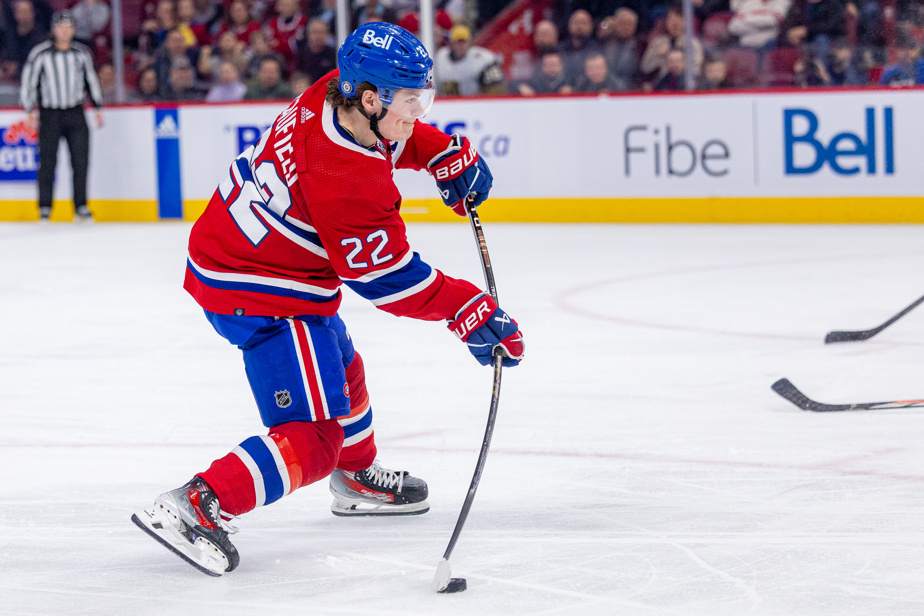If the Canadian’s next 65 games took place at the pace of the first 17, Cole Caufield would conclude the season with 24 goals. Following the same calculation, this harvest, in addition to finding itself clearly below the expectations based on this natural marker, would be boosted by 15 goals in overtime.
This hypothesis is obviously absurd. But it nevertheless reflects Caufield’s production thus far.
The winger scored three of his five goals after 60 minutes of regulation play. He also scored one on the power play and another at five-on-five. In this last category, it is a bit problematic.
Among all NHL forwards who have played at least 200 minutes at five-on-five this season, 73 have scored twice or more. With just one success, Caufield is very far from his cruising speed of the last campaign: 1.61 goals per 60 minutes played, in third place on the circuit, behind David Pastrnak and Jared McCann – and ahead of Connor McDavid.
We can only wonder about this drastic drop in speed in this phase of the game. This drop is transposed, although to a lesser extent, into a numerical advantage.
A glance at a series of individual indicators leaves one wondering.

The observation is as simple as it is brutal: the puck simply does not seem to be entering the goal. Because, at five against five, Caufield generates exactly the same number of expected goals as last year. He even shoots a little more often, despite slightly less ice time.
His efficiency rate, however, is staggering, and not in a good way: barely 2.44% of his shots on target have so far been converted into goals. At last year’s pace, he would have already scored six to seven goals.
The observation is the same on the power play, although he shoots slightly less than before with an extra man or two. The consistency of his expected goals nevertheless suggests that the quality of the shots is there.
At first glance, number 22 did not seem keen on the idea of speaking out about his five-on-five drought. The solution he proposed? “Pull more,” he suggested dryly.
Faced with the astonishment of the representative of The Pressthe attacker has developed somewhat.
These are things that happen. I obviously want to score, and it will come. I will not worry about it. I have to shoot more and keep my confidence.
Cole Caufield
Obviously in a better mood, he later admitted that he missed scoring goals. “It’s the best part of hockey!” “, he said. “I have a good chance, I will end up converting a few. »
” Any further ”
Martin St-Louis put this relative lethargy into perspective. Overtime goals, after all, count as much as any other.
Never mind, he stressed that his protégé is “currently learning to do more on the ice besides scoring.”
“I’m not sure he’s ever been asked that in his young career. We are working on a lot of details. »
The head coach has been talking for a while now about the importance of Caufield playing well without the puck. However, his progress in this chapter is sometimes abstract.
The figures, however, tend towards a real improvement. When the American is on the ice five-on-five this season, the Canadian controls the puck more than last year. He also allows fewer shots and expected goals. On an individual basis, Caufield commits almost half as many turnovers as he did in 2022-23.
“With Martin [St-Louis]we constantly talk about the value of puck possession,” he explained, before listing the “details” he focuses on: his positioning, the way he and his linemates position the puck. puck in space, his anticipation of the opponent’s movements and even his teammates… He also seeks to adapt to the diversified and “aggressive” coverage of other shorthanded teams.
So many things that take time and which, possibly, will cost his record a few goals overall.
“Do you want him to score 50, but not be a complete player and not help his team win? Or that he scores 35 or 40 and is a guy we can use in a lot of situations? », asked Martin St-Louis.
The answer being in the question, we will not add more on this subject. Otherwise to clarify that if, in addition, Caufield could return to a decent conversion rate of his shots on target when there are five CH players on the ice, his life and that of his team would certainly be smoother.
Xhekaj leaves, Harris returns

PHOTO DOMINICK GRAVEL, LA PRESSE ARCHIVES
Arber Xhekaj
After injuring his “upper body” (probably his left shoulder) against the Vegas Golden Knights on Thursday, Arber Xhekaj is “re-evaluated on a daily basis,” indicated the CH. He will therefore miss this Saturday’s game against the Boston Bruins. Jordan Harris, however, will be able to take his place on defense, having missed the last two games with an “upper body” injury. Striker Rafaël Harvey-Pinard, who we do not yet know if he has recovered from the “lower body” injury that deprived him of the last duel, for his part flew to Boston with his teammates, without having trained on Friday.
